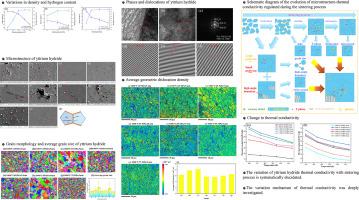Microstructure-thermal conductivity interplay in spark plasma sintered yttrium hydride: effects of sintering parameters on thermal conductivity
IF 14.3
1区 材料科学
Q1 MATERIALS SCIENCE, MULTIDISCIPLINARY
引用次数: 0
Abstract
Yttrium hydride (YHx) has recently attracted considerable attention as a highly promising candidate for the development of compact reactors. This is primarily attributed to its exceptional thermal stability and superior hydrogen storage capacity, which are particularly advantageous under high-temperature conditions. YHx samples were fabricated by spark plasma sintering (SPS) with systematically varied process parameters. Results reveal that the microstructure of sintered YHx exhibits significant variations under different sintering processes. SPS process promotes the densification of sintered YHx monoliths, and the co-evolution of microstructure and grain growth behavior optimizes phonon transport pathways, thereby enhancing the thermal conductivity. The thermal conductivity of sintered YHx decreases with increasing temperature. Optimized under the conditions of 1000°C/65 MPa/5 min, the sintered YHx achieved a relative density of 99.14% and hydrogen content of 1.91 wt.%, exhibiting a maximum thermal conductivity of 67.8 W/(m K) at 300 K. This study conducted an in-depth analysis of the mechanisms influencing thermal conductivity variations and established more comprehensive sintering process-microstructure-thermal conductivity relationships for YHx.

放电等离子体烧结氢化钇中微结构-导热系数的相互作用:烧结参数对导热系数的影响
氢化钇(YHx)作为一种非常有前途的紧凑型反应堆的候选材料,近年来引起了人们的广泛关注。这主要归功于其卓越的热稳定性和卓越的储氢能力,这在高温条件下尤其有利。采用火花等离子烧结(SPS)方法,系统地改变了工艺参数,制备了YHx样品。结果表明:不同烧结工艺下,YHx烧结后的显微组织有明显的变化。SPS过程促进了YHx烧结单体的致密化,微观结构和晶粒生长行为的共同演化优化了声子输运途径,从而提高了导热性。烧结YHx的导热系数随温度的升高而降低。在1000℃/65 MPa/5 min条件下,烧结得到的YHx相对密度为99.14%,氢含量为1.91 wt.%, 300 K时的最大导热系数为67.8 W/(m K)。本研究深入分析了影响YHx导热系数变化的机理,建立了更全面的YHx烧结工艺-微观结构-导热系数关系。
本文章由计算机程序翻译,如有差异,请以英文原文为准。
求助全文
约1分钟内获得全文
求助全文
来源期刊

Journal of Materials Science & Technology
工程技术-材料科学:综合
CiteScore
20.00
自引率
11.00%
发文量
995
审稿时长
13 days
期刊介绍:
Journal of Materials Science & Technology strives to promote global collaboration in the field of materials science and technology. It primarily publishes original research papers, invited review articles, letters, research notes, and summaries of scientific achievements. The journal covers a wide range of materials science and technology topics, including metallic materials, inorganic nonmetallic materials, and composite materials.
 求助内容:
求助内容: 应助结果提醒方式:
应助结果提醒方式:


